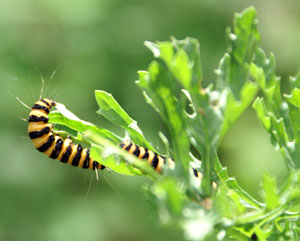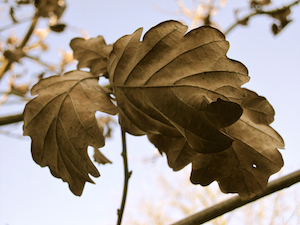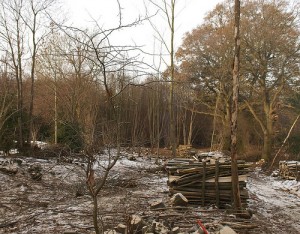Leaf fall …… ?

Knowlands Wood at Barcombe is a hornbeam coppice with a lot of oak, both coppice and standards. When we acquired the wood some thirty years ago, it was mostly dark and relatively lifeless, having remained largely untouched since 1945. A retired forester volunteered to start coppicing and we started to sell logs locally. Within a year, I saw my first White Admiral. The following July my brother, who wanted to see his first also, complained that it was the commonest species of butterfly in the wood.
Coppicing continued, with a short break after the 1987 storm, and now we never allow a year to go by without at least an acre being cut. Thus there is always a variety of habitat – nesting places for four species of warbler and the occasional nightingale, for example. Rides used to meet overhead but are now much wider. I have found letting in light to be the single most effective thing you can do to promote wildlife in a wood. I have also reinstated an old gamekeeper’s field which ensures a marvellous show of spring flowers and a spectacular butterfly and insect population in the summer. We sell logs, so the wood provides my gym, my wildlife reserve and even a little income. Also an education.
George Bernard Shaw: The more you learn, the more you know. The more you know, the more you forget. The more you forget, the less you know. So why bother to learn? But I warm more to Socrates: The more I learn, the more I learn how little I know.
The oaks in Knowlands Wood continue to intrigue me. Many were reluctant this year to part with their leaves. The hard weather at the end of November began to change their minds. After the December snow fell, a brown carpet of oak leaves appeared on top. Most of the trees are now (10th January) bare but here and there some not only still carry leaves but green leaves. They are Quercus robur, the Pedunculate or English Oak. I have been delving into the reasons.
Some oak species, although deciduous, retain dead leaves through the winter, dropping them in spring when the new leaves grow. This is called marcescence. You will be familiar with hornbeam and beech hedges which remain covered in leaves through the winter. [The photo (opposite) shows a marcescent oak - courtesy of Mike Pepler]
The point where the leaf stalk (the petiole) is attached to the twig is called the abscission layer. In autumn, the area becomes sealed and a digestive enzyme helps to release the leaf. It still doesn’t explain why some individual trees behave differently and why especially this year. And why some of the trees at Knowlands still have green leaves.
Dr. Patrick Roper, that great authority on everything, pointed me to “Physiology of the Oak Tree” by K. A. Longman & M. P. Coutts, in “The British Oak” (1974) edited by M. G. Morris and F. H. Perring and published by the Botanical Society of the British Isles. He quotes:
“An unusual feature of many oak trees is the retention during the winter of dead brown leaves, the abscission layer often not completing until spring. Common names for Q. petraea, (Wintereiche, Chêne d’hiver) indicate its special tendency in this respect, although retention was more prevalent in the Q. robur in German provenance trials.  Although sizeable trees, especially, especially of Q. petraea, can retain leaves right to the top, the habit is most pronounced in young trees, coppice and low epicormic branches, resembling the clear-cut juvenile stage of leaf retention in Fagus sylvatica. The tendency to retain or lose leaves is strongly inherited in oak, as has been shown in grafting experiments and by controlled breeding.
Although sizeable trees, especially, especially of Q. petraea, can retain leaves right to the top, the habit is most pronounced in young trees, coppice and low epicormic branches, resembling the clear-cut juvenile stage of leaf retention in Fagus sylvatica. The tendency to retain or lose leaves is strongly inherited in oak, as has been shown in grafting experiments and by controlled breeding.
Although a relationship has been claimed between leaf-retention and greater growth rates, the physiological significance of this habit remains unclear. It possibly represents a vestigial expression of the evergreen habit shown by most Quercus spp; during mild winters and in the tropics, seedlings and coppice shoots of European oaks can retain green leaves until the new ones appear, showing what is strictly speaking a ‘leaf-exchanging’ habit.”
Dr. Roper suspects the hypothesis in the last sentence is probably correct and because the cold came early in the winter, green leaves were still on some of the oaks.
(to visit Dr Roper's blog, click here)
Comments are closed for this post.
Discussion
hi my oak tree has brown leaves still on it is it dead?
I was intrigued to read of the habit of oaks retaining their leaves. Here, in Southern Italy, it seems to be common for the oaks to retain leaves until the new ones come in the Spring. The dead brown leaves remain a feature, and weather conditions to not appear to affect this. Each year it is the same. They are released when the new leaves come. Thank you for your welcome information. It has helped to explain a local phenomenon.
I spend alot of time in Knowlands wood,and it is just amazing to see the different changes that is going on up there with the wild flowers,some new fungus which I haven’t seen before,wild life all around you and just nature every day is different, keep going Nick with all your hard work in managing your woodland.
Love
Alison


Best to wait and see : some oak leaves retain brown leaves until the following Spring – this is known as marcescence. As in the blog above : quote “An unusual feature of many oak trees is the retention during the winter of dead brown leaves, the abscission layer often not completing until spring.”
Chris
4 April, 2011